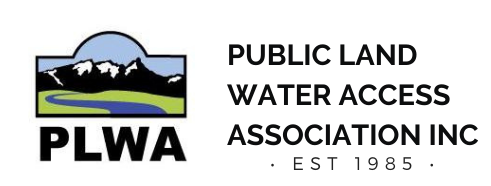
Can A Landowner Fence Across A River?
PUBLIC ACCESS AND FENCING ACROSS RIVERS
Even though we have a stream access law and an accompanying bridge access law, this does not prevent landowners from fencing across the river, or from partially fencing into the body of the river. In any river with a significant spring run off this is often not feasible due to damage caused by debris floating down the river. However, a recreationist using a river can portage around the fence or obstruction using the “least intrusive manner”.
There is no requirement for landowners to construct or pay for official or unofficial portage sites.
While a landowner can fence to a bridge abutment, subject to the provisions of the bridge access law, a fence across the river, directly under a bridge, would constitute an illegal encroachment of a public right-of-way.
The Right to Portage - Establishment of A Portage Route
This concept is described in MCA 23-2-311. It states:
(1) A member of the public making recreational use of surface waters may, above the ordinary high-water mark, portage around barriers in the least intrusive manner possible, avoiding damage to the landowner’s land and violation of the landowner’s rights.
(2) A landowner may create barriers across streams for purposes of land or water management or to establish land ownership as otherwise provided by law. If a landowner erects a structure that does not interfere with the public’s use of the surface waters, the public may not go above the ordinary high-water mark to portage around the structure.
(3) (a) A portage route around or over a barrier may be established to avoid damage to the landowner’s land and violation of the landowner’s rights, as well as to provide a reasonable and safe route for the recreational user of the surface waters.
(b) A portage route may be established when either a landowner or a member of the recreating public submits a request to the supervisors that a route be established.
(c) Within 45 days of the receipt of a request, the supervisors shall, in consultation with the landowner and a representative of the department, examine and investigate the barrier and the adjoining land to determine a reasonable and safe portage route.
(d) Within 45 days of the examination of the site, the supervisors shall make a written finding of the most appropriate portage route.
(e) The cost of establishing the portage route around artificial barriers must be borne by the department, including the cost of construction of notification signs of the route.
(f) Once the route is established, the department has the exclusive responsibility to maintain the portage route at reasonable times agreeable to the landowner. The department shall post notices on the stream of the existence of the portage route and the public’s obligation to use it as the exclusive means around a barrier.
(g) If either the landowner or the recreationist disagrees with the route described in subsection (3)(e), the person may petition the district court to name a three-member arbitration panel. The panel must consist of an affected landowner, a member of an affected recreational group, and a member selected by the two other members of the arbitration panel. The arbitration panel may accept, reject, or modify the supervisors’ finding under subsection (3)(d).
(h) The determination of the arbitration panel is binding upon the landowner and upon all parties that use the water for which the portage is provided. Costs of the arbitration panel, computed as for jurors’ fees under 3-15-201, must be borne by the contesting party or parties. All other parties shall bear their own costs.
(i) The determination of the arbitration panel may be appealed within 30 days to the district court.
(j) Once a portage route is established, the public shall use the portage route as the exclusive means to portage around or over the barrier.
(4) This part does not address the issue of natural barriers or portage around the barriers, and this part does not make the portage lawful or unlawful.
NOTE: Subsection 2 refers to things like “float gates” – hanging PVC pipe – which keep cattle in, but do not obstruct floaters.
For reference, review the Stream Access Law in full here:
Montana’s Stream Access Law – MCA 23-2-3
Even though the 1985 SAL did not take away the right of a landowner to fence across the river, or from putting a fence part way into the river, it did state that a recreationist using a river, can portage around the fence obstruction using the “least intrusive manner”. The 2009 Bridge Access Law did not change that.
